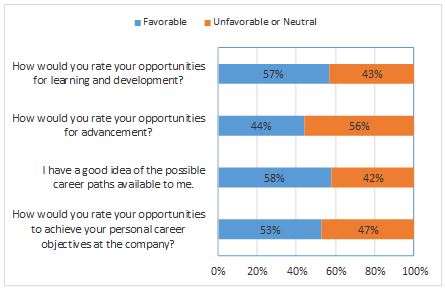January 13, 2017
KEY #1: KNOW YOUR EMPLOYEES
Your starting point is to know what your people are looking for — don’t blindly follow other companies’ best practices. Gather feedback by enhancing your employee feedback processes. The information you gather will assist in understanding what your people want and need. Then you can concentrate on maintaining what you do well and improving what you don’t do so well. This targets your efforts to areas with the highest potential return on retention.
There are a number of ways to gather upward feedback. One is to hold small, open forums, conducted by the owner or senior manager, where you ask for employee input on being an effective employer. Ask, What motivates you to stay with our company? What would lure you away? Which of our benefits are most meaningful to you? What could we do differently?
Another method is to conduct exit interviews to find out why people are leaving. Quite often, an exiting employee is more willing to provide open and truthful input than current employees. Ask, What could we have done to keep you with our company? What suggestions do you have to improve how we deal with our people? Look for trends and suggestions that you could implement and match it to what you have heard from other employees.
A third method is to conduct employee surveys, then DO SOMETHING about the results. Don’t try to ask too many questions. If your survey is too long and provides you with too much feedback, you’ll have a hard time fulfilling all the needs identified. This will disillusion employees and make them feel like you weren’t serious.
Get to know your individual employees by walking around, asking questions, and going for lunch or coffee. Don’t have time you say? What does this say to your employees? My manager doesn’t care about me as a person – I’m just a worker. Take care you aren’t sending the wrong message – be available and personable.
Examine your employee demographics. Do single mothers work for you? Offer flex–time, job shares, or subsidized day care. What about working around school schedules? Younger employees may prefer technical freebies like iPods. If you have family oriented staff don’t forget the employees’ families when planning events, celebrate their children’s accomplishments, and consider contributing to their children’s education.
When you find something that isn’t important to your employees STOP spending money on it. Instead spend these dollars on something that is important.
KEY #2: CREATE AN EMPLOYEE CENTERED ENVIRONMENT
Send a clear message that your employees are important. Do this by creating an open and flexible workplace that contributes to work-life balance. Today’s employees want time to enjoy life beyond work so employers who can offer flexible work arrangements will be positively viewed. Innovative benefits that support employee health and wellness will also be welcomed. But again, don’t just blindly apply these practices – find out which are more important to your employees. Whatever you choose to offer must fit within your operational needs but don’t be too rigid – it could cost you the loss of good employees.
Consider a flexible hour policy that establishes core hours but otherwise the employee’s hours are flexible within an eight hour day. For example, each employee must work from 10 am to 3 pm, but can choose to start anytime between 7 am and 10 am. They can also choose to end earlier or later dependent upon their personal situations.
Another option is to offer flexible work schedules that allow more time off. For example, the employee works four ten-hour days per week instead of 5 eight-hour days; the employee works longer days to get every second Friday off. A job share is where two employees share a job thus working a shorter work week on days of their choosing.
Benefits can be expensive for small employers. Therefore, consider letting the employee choose what they need from a variety of benefits. In addition to the standard health and pension benefits, a hygiene factor for all businesses, add childcare or eldercare support; allow employees to use their personal sick days for family care needs; allow employees to purchase additional vacation days; allow one “sanity day” per quarter; subsidize public transport or moving expenses; offer rent subsidies; subsidize or provide gym or fitness memberships.
KEY #3: REWARD & RECOGNIZE TOP PERFORMERS
While each employee should receive a fair, competitive compensation and benefits package, you must find ways to recognize and reward your top performers. Fortunately, this recognition can be something other than pay.
As simple as it sounds, say “thank you”. Provide immediate, specific acknowledgement of work well done and make it personal. Let the employee know why it was of value to the team and the company. Also recognize the achievement at a staff meeting.
Show your top performers you value their opinions by asking for input on decisions, work processes, and business direction. Involve them in company projects. This makes employees feel respected and valued.
Establish recognition expectations for supervisors and managers. Don’t leave it to chance or it may never get done. Encourage staff to recognize one another by creating a peer recognition program with small tokens such as movie passes, lunch gift certificates, or lottery tickets. You could even create an annual Employee Recognition Program where you nominate staff for special achievements and celebrate in a splashy manner.
Celebrate key company or department achievements. This could be meeting sales targets, meeting a company milestone, or just working through a busy, difficult week. Let employees know you’ve noticed their accomplishment. Don’t let it go by without recognition. It doesn’t have to be big – just personal. Examples include bringing pizza or Chinese food in, closing one hour early on a long weekend, giving a pass for one hour or one day off of the employee’s choosing. Make your recognition consistent with what employees’ value.
You may also wish to consider offering cash bonuses to your top performers or critical positions. Provide a share of the company profit to the employee in relation to their contribution or provide on-the-spot bonuses.
KEY #4: PROVIDE EFFECTIVE LEADERSHIP & SUPERVISION
Show employees you have what it takes to get the job done. Everyone likes to work for a winner! Share your leadership vision and tell employees how they fit in. Make them feel part of something bigger than themselves and their individual jobs.
Banish command and control. Today’s supervisors have to demonstrate effective people skills and can no longer practice Theory X management techniques. You can’t afford to have uni-dimensional mangers that are good technically but lack the skills to motivate and develop direct reports. People leave jobs due to poor supervisors so you must hold your supervisors accountable for employee turnover and retention. Set your expectations and provide up-to-date training. However, when training is provided explain that there will be consequences of not changing their behaviour to more positive supervisory models. Then follow through when supervisors continue to exhibit negative behaviours.
KEY #5: PROVIDE OPPORTUNITIES FOR DEVELOPMENT
Global Market Insite, Inc. (GMI), a provider of global market intelligence solutions, surveyed over 5,000 full and part time workers in international markets. When asked what a boss could do more of, Canadian workers top priority (39%) was “use my skills and abilities” and a quarter (26%) asking for bosses to ‘encourage my development’. So what can an employer do?
Firstly, examine your onboarding process. Make the employee’s orientation a day to remember – don’t make the employee sorry they joined your organization. Set up effective training processes for new employees – don’t just expect them to be successful without proper support.
Don’t think of employee development as just training. It’s more than that. Employee development includes mentoring and buddy systems, external education and conferences, joining associations, job shadowing, cross training, increasing the employee’s responsibility and/or complexity in their current role, job rotation, and temporary assignments in other departments or positions. Ensure employees have the time to take advantage of these development opportunities by making the development of employees a priority for your supervisors.
Create opportunities for self-development by budgeting educational/training funds, allowing paid/unpaid development days, offering paid/unpaid sabbaticals, offering tuition support, and providing in-house training. Companies should also consider providing non-job related continuing education support to some or all workers.
The above 5 keys to employee retention provide a number of considerations for the small business. Not all of them will apply or work within your specific work environment but hopefully there is enough “food for thought” to provide you with some practical ideas to implement within your business.
Reprinted with permission. Barbara Adams, Managing Director of HR architects, specializes in bringing a business approach to your organization’s human resources practices. Applying a coaching style, she takes a creative yet structured approach when completing consulting projects in the areas of human resources planning and strategy, employee development strategies and design work, customized training solutions, meeting and planning facilitation, and human resources practices and processes.
go2HR is BC’s tourism and hospitality , human resources and health & safety association driving strong workforces and safe workplaces that deliver world class tourism and hospitality experiences in British Columbia. Follow us on LinkedIn or reach out to our team.
Return to top


